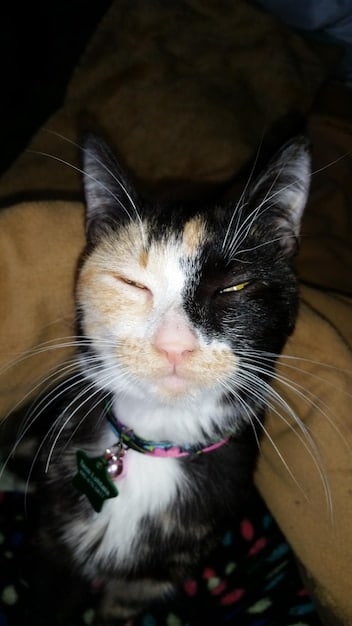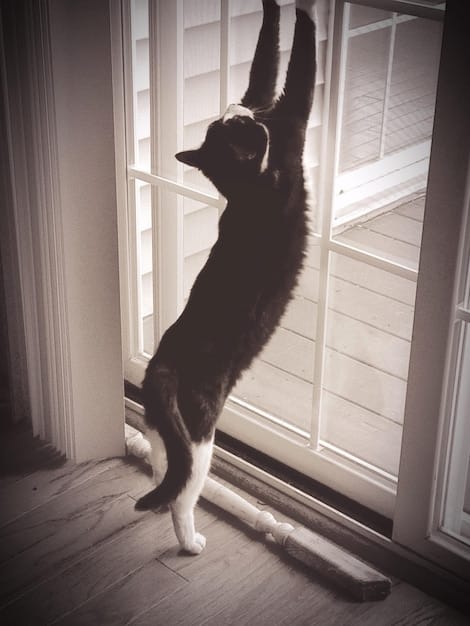The Silent Killer: Recognizing and Managing Arthritis Pain in Senior Cats

Recognizing and managing arthritis pain in senior cats, often called “the silent killer,” involves keen observation, environmental adjustments, veterinary care, and possibly medication to improve their quality of life.
As cats gracefully age, they often face health challenges that can significantly impact their quality of life, including the silent killer: recognizing and managing arthritis pain in senior cats. This condition, frequently underestimated or overlooked, can cause chronic discomfort, limiting mobility, and diminishing their overall well-being.
Understanding Arthritis in Senior Cats
Arthritis is a common condition in older cats, but it can be challenging to detect. Many cats are masters at hiding their discomfort, so understanding the signs and symptoms is crucial for early intervention.
What is Arthritis?
Arthritis, or osteoarthritis, is a degenerative joint disease characterized by the breakdown of cartilage, the cushioning tissue between bones. This leads to pain, inflammation, and reduced joint mobility.
Causes of Arthritis in Cats
Arthritis in cats can be caused by various factors, including genetics, age, previous injuries, or obesity. It’s a progressive condition that worsens over time.
- Genetics: Some cats are predisposed to developing arthritis due to their genetic makeup.
- Age: As cats age, the cartilage in their joints naturally wears down.
- Injuries: Past injuries, such as fractures or dislocations, can increase the risk of arthritis.
- Obesity: Excess weight puts additional stress on joints, accelerating cartilage breakdown.
Understanding the causes can help you take preventive measures and manage the condition more effectively.
Recognizing the Subtle Signs of Arthritis
One of the biggest challenges in managing arthritis in senior cats is recognizing the subtle signs of the condition. Cats are known for their stoic nature, often masking pain until it becomes severe.

Changes in Behavior
Keep an eye out for changes in your cat’s behavior, as these can be indicators of pain and discomfort. Subtle shifts in their daily routine can signal underlying health issues.
Physical Symptoms to Watch For
Physical symptoms can also provide clues about your cat’s joint health. Pay attention to any changes in their movement, grooming habits, and posture.
- Reduced Activity: Reluctance to jump, climb stairs, or play.
- Stiffness: Noticeable stiffness when getting up after resting.
- Grooming Changes: Neglecting grooming, especially around the back and hips.
- Altered Posture: Arched back or reluctance to be touched certain areas.
Recognizing these signs early can make a significant difference in your cat’s comfort and quality of life.
Diagnosing Arthritis in Senior Cats
If you suspect your cat has arthritis, it’s crucial to consult with a veterinarian for a proper diagnosis. A thorough examination and diagnostic tests can confirm the condition and rule out other potential causes of discomfort.
Veterinary Examination
Your vet will perform a physical examination, checking your cat’s joints for swelling, pain, and reduced range of motion. They will also assess your cat’s overall health and look for any other underlying issues.
Diagnostic Tests
Various diagnostic tests can help confirm the presence and severity of arthritis. These tests provide valuable information for developing an effective management plan.
During the examination, your vet may:
- Palpate the joints to assess for swelling, heat, and pain upon manipulation.
- Observe your cat’s gait and posture for signs of stiffness or lameness.
- Ask about your cat’s behavior, including changes in appetite, sleep patterns, and social interactions.
Common diagnostic tests include:
- X-rays to evaluate joint structure and identify signs of cartilage damage or bone spurs.
- Blood tests to rule out other conditions, such as infections or immune-mediated diseases.
- Joint fluid analysis to assess inflammation and identify any abnormalities.
A definitive diagnosis is essential for creating an individualized treatment plan tailored to your cat’s specific needs.

Managing Arthritis Pain Through Environmental Adjustments
Making simple changes to your cat’s environment can significantly ease their discomfort and improve their mobility. These adjustments help minimize stress on their joints and make daily activities easier.
Creating a Comfortable Living Space
Ensure your cat has a cozy and accessible living space that caters to their needs. A few adjustments can make a big difference in their comfort.
Assistive Aids for Mobility
Provide assistive aids to help your cat navigate their environment more easily. These tools can reduce strain on their joints and prevent further injury.
Consider the following:
- Provide soft, padded bedding in warm, draft-free areas to cushion joints.
- Place food and water bowls at an elevated height to reduce strain on the neck and back.
- Ensure litter boxes have low sides for easy access.
Some helpful aids include:
- Ramps or steps to help your cat reach their favorite spots, such as windowsills or beds.
- Non-slip mats on hard floors to prevent slipping and falling.
- Heated beds to provide soothing warmth and reduce joint stiffness.
By creating a supportive environment, you can significantly improve your cat’s comfort and mobility.
Medical Treatments for Arthritis
In addition to environmental adjustments, medical treatments play a vital role in managing arthritis pain in senior cats. Your veterinarian can recommend various medications and therapies to alleviate discomfort and improve joint health.
Pain Management Medications
Pain management medications can help reduce inflammation and relieve pain, allowing your cat to move more freely.
Alternative Therapies
Alternative therapies offer a complementary approach to managing arthritis pain, often working in conjunction with medications.
Common medications include:
- Nonsteroidal anti-inflammatory drugs (NSAIDs) to reduce inflammation and pain.
- Pain relievers, such as opioids or gabapentin, for more severe pain.
- Joint supplements, such as glucosamine and chondroitin, to support cartilage health.
Alternative therapies may include:
- Acupuncture to stimulate the release of endorphins and reduce pain.
- Physical therapy to improve joint mobility and strengthen muscles.
- Laser therapy to reduce inflammation and promote healing.
Always consult with your veterinarian before starting any new medications or therapies to ensure they are safe and appropriate for your cat.
The Role of Diet and Exercise
A balanced diet and regular exercise are essential for managing arthritis in senior cats. Proper nutrition helps maintain a healthy weight, reducing stress on joints, while gentle exercise keeps muscles strong and joints flexible.
Nutritional Considerations
Choose a high-quality diet that supports joint health and helps maintain an ideal weight. Certain nutrients can also provide additional benefits.
Gentle Exercise and Activity
Encourage gentle exercise to keep your cat active and maintain joint flexibility. Avoid activities that put excessive stress on their joints.
Key dietary considerations include:
- Weight management: Obesity exacerbates arthritis pain, so maintaining a healthy weight is crucial.
- Joint supplements: Diets enriched with glucosamine, chondroitin, and omega-3 fatty acids can support cartilage health.
- Anti-inflammatory nutrients: Foods rich in antioxidants can help reduce inflammation in the joints.
Safe and effective exercises include:
- Short, frequent play sessions with interactive toys to stimulate movement.
- Gentle stretching exercises to maintain joint flexibility.
- Encouraging movement by placing food bowls and litter boxes in different locations.
A tailored diet and exercise plan can help your cat maintain a healthy weight, improve joint health, and enhance their overall well-being.
| Key Point | Brief Description |
|---|---|
| 🔍 Early Detection | Recognizing subtle signs like reduced activity is crucial. |
| 🏡 Environmental Adjustments | Make changes like providing ramps and soft bedding. |
| 💊 Medical Treatments | Medications and therapies can alleviate discomfort. |
| 🐾 Diet & Exercise | Balanced diet and gentle exercise are essential. |
Frequently Asked Questions
▼
Early signs include decreased activity, stiffness, reluctance to jump, and changes in grooming habits. You might also notice your cat is less playful or spends more time resting.
▼
A vet diagnoses arthritis through a physical exam, observing movement, and diagnostic tests like X-rays to assess joint damage, and blood tests to rule out other conditions with similar symptoms.
▼
Yes, environmental changes can greatly help. Provide soft bedding, ramps to favorite spots, elevated food bowls, and low-sided litter boxes to make life easier and more comfortable for an arthritic cat.
▼
Medications can include NSAIDs to reduce inflammation, pain relievers like gabapentin, and joint supplements like glucosamine. Always consult your vet for the best options and dosages.
▼
A balanced diet helps maintain a healthy weight, reducing joint stress. Gentle exercise keeps joints flexible. Diets rich in omega-3 fatty acids and antioxidants support joint health and reduce inflammation.
Conclusion
Managing arthritis pain in senior cats requires a comprehensive approach that involves recognizing subtle signs, consulting with a veterinarian, making environmental adjustments, considering medical treatments, and implementing a proper diet and exercise plan. By taking these steps, you can significantly improve your cat’s comfort, mobility, and overall quality of life.





